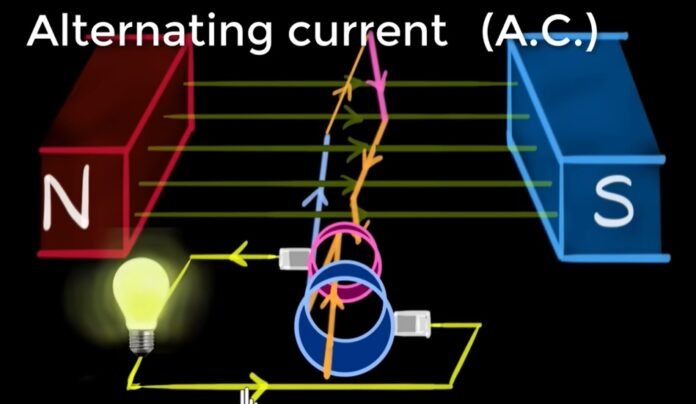What is an AC Generator?
An AC generator is an electric generator that converts mechanical energy into electrical energy in the form of alternative emf or alternating current. An AC generator works on the principle of “Electromagnetic Induction”.
What is a DC Generator?
A DC generator is a machine that converts mechanical energy into DC (direct current) electricity. The energy alteration process uses the principle of energetically induced electromotive force.
What are the differences between AC and DC Generator?
| Sl. No. | Differentiating Property | AC Generator | DC Generator |
|---|---|---|---|
| 1 | Definition | AC generator is a mechanical device that converts mechanical energy into AC electrical power. | DC generator is a mechanical device that converts mechanical energy into DC electrical power. |
| 2 | Direction of Current | In an AC generator, the electrical current reverses direction periodically. | In a DC generator, the electrical current flows only in one direction. |
| 3 | Basic Design | In an AC generator, the coil through which the current flows is fixed while the magnet moves. The construction is simple and costs are less. | In a DC generator, the coil through which the current flows rotate in a fixed field. The overall design is very simple but construction is complex due to commutators and slip rings. |
| 4 | Commutators | AC generator does not have commutators. | DC generators have commutators to make the current flow in one direction only. |
| 5 | Rings | AC generators have slip-rings. | DC generators have commutators. |
| 6 | Efficiency of Brushes | Since slip-rings have a smooth and uninterrupted surface, they do not wear quickly and are highly efficient. | Both brushes and commutators of a DC generator wear out quickly and thus are less efficient. |
| 7 | Short Circuit Possibility | As the brushes have high efficiency, a short circuit is very unlikely. | Since the brushes and commutators wear out quickly, sparking and short circuit possibility is high. |
| 8 | Rotating Parts | The rotating part in an AC Generator is a low current high resistivity rotor. | The rotating part in a DC generator is generally heavy. |
| 9 | Current Induction | In an AC generator, the output current can be either induced in the stator or in the rotor. | In a DC generator, the output current can only be induced in the rotor. |
| 10 | Output Voltage | AC generators produce a high voltage which varies in amplitude and time. The output frequency varies (mostly 50Hz to 60Hz). | DC generators produce a low voltage when compared to AC generator which is constant in amplitude and time i.e. output frequency is zero. |
| 11 | Maintenance | AC generators require very little maintenance and are highly reliable. | DC generators require frequent maintenance and are less reliable. |
| 12 | Types | AC generators can be of varying types like 3 phase generators, single-phase generators, synchronous generator, induction generator, etc. | DC generators are mainly two types which are Separately excited DC generator and self-excited DC generator. According to field and armature connection, they can be further classified as DC series, shunt, or compound generators, respectively. |
| 13 | Cost | The initial cost of an AC generator is high. | The initial cost of a DC generator is less when compared to AC generators. |
| 14 | Distribution and Transmission | The output from AC generators is easy to distribute using a transformer. | The output from DC generators is difficult to distribute as transformers cannot be used. |
| 15 | Efficiency | AC generators are very efficient as the energy losses are less. | DC generators are less efficient due to sparking and other losses like copper, eddy current, mechanical, and hysteresis losses. |
| 16 | Applications | It is used to power smaller motors and electrical appliances at homes (mixers, vacuum cleaners, etc.) | DC generators power very large electric motors like those needed for subway systems. |
Recommended Articles:
Dichromate: Introduction, Structure, Preparation, Properties And Uses
Dielectric Constant: Introduction, Formula, Units, Symbol, And Theory
Dielectric Material And Dipole Moment
Dielectrics: Introduction, Materials, Molecules, Polarization And constant
Dielectric Properties: Introduction, Constant, Strength, And Applications
The similarities between AC generators and DC generators are that both work on the relative motion of a coil between the coil of the wire and the magnetic field which is used in the production of electricity. In both the generators alternating current is produced but in DC generator, the commutator is used in the conversion of direct current into alternating current. There are two types of AC generators and they are: Induction generators An induction generator is also known as an asynchronous generator that has a working principle similar to that of an AC generator. The only difference between a normal AC generator and an induction generator is that the induction generator is a rotating device. It is known as asynchronous because the speed of the induction generator is less than that of the synchronous generator. They find applications in mixers and grinders. A split-ring commutator is used for the conversion of the AC generator into the DC generator. When a slipt-ring commutator is used, it makes the current change its direction after every alternate half-cycle. It basically reverses the direction of the current after every half rotation and this helps in maintaining the current in positive half-cycle. Difference Between Ac And Dc Generator FAQs
What are the similarities between AC generators and DC generators?
How many types of AC generators are there?
Synchronous generatorsWhat is an induction generator?
How to convert AC generator into DC generator?
